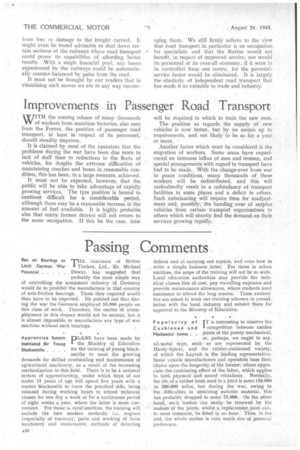Passing Comments
Page 18

Page 19

If you've noticed an error in this article please click here to report it so we can fix it.
Ban on Bearings to THE chairman Of British Limit 'German War I Timken, Ltd., Mr. Michael
Potential Dewar, has suggeted that probably the most simple way of controlling the armament industry of Germany would be to prohibit the manufacture in that country of anti-friction bearings. Those they required would then have to be imported. He pointed out that during the war the -Germans employed 55,000 people on this class of work, Therefore, the matter of unemployment in this respect would not be serious; but it is almost impossible to manufacture any type of war machine without such bearings.
Apprentice System pLANS have been made by Instituted fdr Young I the Ministry of Education Blacksmiths . . for the training of young black smiths to meet the growing demands for skilled overhauling and maintenance of agricultural machinery, as a result of the increasing mechanization in this field. There is to be a national system of apprenticeship, under which boys of not under 15 years of age will spend five years with a master iblacksmith to learn the practical side, being released during working hours to attend technical classes for one day a week or for a continuous period of eight weeks a year, where the latter is more convenient. For those in rural-smithies, the training will include the best modern, methods; i.e. engines (especially. of tractors); parts and working at farm machinery and imulemerits; methods' of detecting AN •
defects and of carrying out repairs, and even how to .„ write a simple business Jetter. For those in urban smithies, the scope of the training will not be so wide. Local education authorities may provide the technical classes free of cost, pay travelling expenses and provide maintenance allowances, where students need assistance to attend the long session. These authorities are asked to work out training schemes in consultation with the local industry and submit them for approval to the Ministry of tducation.
Popular i ty of IT is interesting to observe the Cushioned an d-1 competition between carden • . Mechanical Joints . . joints. of the purely mechanical, or, perhaps, we ought to say. all-metal type, such as are represented by the Hardy-Spicer, and the rubber7cushioned variety, of which the Layrub is the leading representative. Some vehicle manufacturers and operators base their choice upon the longevity of the former; others appreciate the cushioning effect of the latter, which applies to both physical and sound vibrations. Normally, the life of a rubber bush used in a joint is some 150,000 ' to 200,000 miles, but during the war, owing to the difficulties in obtaining suitable material, this has probably dropped to some 75,000. On the other hand, such bushes can easilybe renewed by the makers Of the jointh, whilst a replacement Joint cart,. in most instances, be fitted in an hour. Thils, in the end, the whole matter is very much one :of personal preference. Some Modern Views A T a recent meeting of the onOil Engine DevelopiThAmerican Society of Auto !Tient motive Engineers to discuss oil fuels and lubricants, it was _prophesied that offt development in the power field would be a combined engine, supercli-arger and turbine for heavy duty. The supercharger would • increase the power output by about SO per cent:. _ whilst the turbine would perform, useful work in 'driving the former. Amongst other 'possibilities cited was that of utilizing the oil engine to function as a combustion chamber for the turbine and to drive the supercharger, with 'the turbine then becoming the main source of power. A representative of Central A Greyhound. Lines, a leading bus operator, warned members that the oil engine cannot rest on its-present laurels of fuel economy, any advantage in this connection being lost unless related costs of maintenance can be held at about the level of competitive power sources. He predicted the development, in the next few years, of a two-stroke-cycle Niariable-compression oil engine, free from complication, burning a variety of fuels, and particularly satisfactory for motor. vehicles.
Battery-vehicle rROM an announcement by Makers Disappointed
the Electric Vehicle AssociaOver Materials . . . tion of Great Britain, it appears that its negotiations with the M.O.S. for facilities to produce 500 standard-type electric -vehicles have been suspended. The reason given is that sufficient suitable materials are not yet available. As types other than the battery-electric are getting into production, it seems rather hard on this particular one that it is receiving such scant consideration. Is it possible that the authorities concerned would rather save electricity than liquid. fuel?




















































